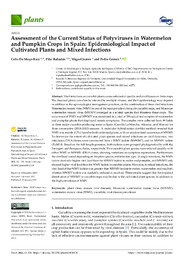Título :
Assessment of the Current Status of Potyviruses in Watermelon and Pumpkin Crops in Spain: Epidemiological Impact of Cultivated Plants and Mixed Infections |
Autor :
De Moya Ruiz, Celia 
Rabadán, Pilar 
Juárez Gómez, Miguel 
Gómez López, P. |
Editor :
MDPI |
Departamento:
Departamentos de la UMH::Producción Vegetal y Microbiología |
Fecha de publicación:
2021-01-12 |
URI :
https://hdl.handle.net/11000/30774 |
Resumen :
Viral infections on cucurbit plants cause substantial quality and yield losses on their crops. The diseased plants can often be infected by multiple viruses, and their epidemiology may depend, in addition to the agro-ecological management practices, on the combination of these viral infections. Watermelon mosaic virus (WMV) is one of the most prevalent viruses in cucurbit crops, and Moroccan watermelon mosaic virus (MWMV) emerged as a related species that threatens these crops. The occurrence of WMV and MWMV was monitored in a total of 196 apical-leaf samples of watermelon and pumpkin plants that displayed mosaic symptoms. The samples were collected from 49 fields in three major cucurbit-producing areas in Spain (Castilla La-Mancha, Alicante, and Murcia) for three consecutive (2018–2020) seasons. A molecular hybridization dot-blot method revealed that WMV was mainly (53%) found in both cultivated plants, with an unadvertised occurrence of MWMV. To determine the extent of cultivated plant species and mixed infections on viral dynamics, two infectious cDNA clones were constructed from a WMV isolate (MeWM7), and an MWMV isolate (ZuM10). Based on the full-length genomes, both isolates were grouped phylogenetically with the Emergent and European clades, respectively. Five-cucurbit plant species were infected steadily with either WMV or MWMV cDNA clones, showing variations on symptom expressions. Furthermore, the viral load varied depending on the plant species and infection type. In single infections, the WMV isolate showed a higher viral load than the MWMV isolate in melon and pumpkin, and MWMV only showed higher viral load than the WMV isolate in zucchini plants. However, in mixed infections, the viral load of the WMV isolate was greater than MWMV isolate in melon, watermelon and zucchini, whereas MWMV isolate was markedly reduced in zucchini. These results suggest that the impaired distribution of MWMV in cucurbit crops may be due to the cultivated plant species, in addition to the high prevalence of WMV
|
Palabras clave/Materias:
Plant virus
Mosaic viral diseases
Moroccan watermelon mosaic virus (MWMV)
Watermelon mosaic virus (WMV)
Cucurbits
Viral disease prevalence |
Tipo documento :
application/pdf |
Derechos de acceso:
info:eu-repo/semantics/openAccess
Attribution-NonCommercial-NoDerivatives 4.0 Internacional |
DOI :
https://doi.org/10.3390/plants10010138 |
Aparece en las colecciones:
Artículos Producción vegetal y microbiología
|

 La licencia se describe como: Atribución-NonComercial-NoDerivada 4.0 Internacional.
La licencia se describe como: Atribución-NonComercial-NoDerivada 4.0 Internacional.
.png)